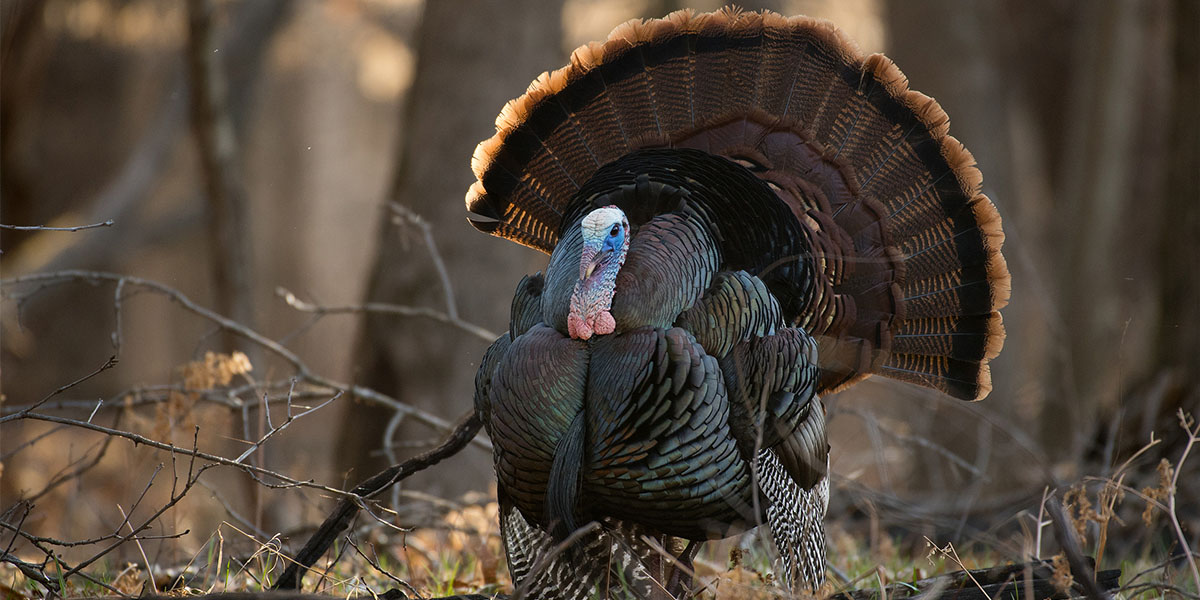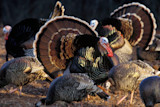
The wild turkey is one of the most widely distributed game animals in North America, with huntable numbers in every state except Alaska. Estimates put the country’s total population at about 7 million, made up of five different wild turkey subspecies. Each subspecies looks, sounds, and acts a bit differently, which should influence how you hunt them.
Eastern Turkey Subspecies
Eastern turkeys are the most populous in the country with a flock size of about 5.3 million. They’re found in every state east of the Missouri River, with transplant populations in Washington, Montana, and California.
Easterns are the heaviest of the turkey subspecies, with weights regularly exceeding 25 pounds. They also have the longest beards and loudest gobbles, and compete with Osceolas for the longest spurs and darkest feathers. Their tail fans are copper to bronze in color.
According to hardcore turkey hunters, Easterns are the most difficult subspecies to hunt. But that likely has less to do with their intelligence and more to do with the populated states that they call home. You’re unlikely to find a tom that hasn’t had run-ins with other sweet-talking hunters, so their tolerance for poor calling and unrealistic decoys is low.
Merriam’s Turkey Subspecies
Merriam’s are as widely distributed as Easterns, with strongholds in pretty much every state west of the Missouri River. Their overall population, however, is significantly lower. With more predators and less habitat, Merriam’s flocks are scattered across the region.
Of all the turkey subspecies, Merriam’s have the quietest gobble, shortest beards, shortest spurs, and lightest colored fans (besides Gould’s). Although hybridizing with Easterns has altered the characteristics of some flocks in the Great Plains, a pure Merriam’s will have buff-colored tailfeathers.
Because they tend to live in more rugged areas, Merriam’s are considered to be the easiest subspecies to hunt. Unpressured birds in the West are usually more eager to answer a hunter’s call and stroll into decoy setups. The rough places they call home, from the mountains of Idaho to the deserts of New Mexico, don’t always make them easy to locate though.
Rio Grande Turkey Subspecies
Rio Grande turkeys have similar population numbers to Merriam’s, but their distribution is far more limited. Although they’re found from North Dakota to Hawaii, their primary range is from Kansas to Texas and Washington to California.
Rios are kind of a tweener between Easterns and Merriam’s. They have medium-sized beards and spurs with tailfeathers that are tan. The habitat they call home is somewhere in the middle, as well: arid plains, brush country, cottonwood bottoms, big ag.
Like Merriam’s, Rios tend to be pretty nomadic. Where they roost is rarely where they’ll be found late morning, afternoon, or evening. Their hangouts are more predictable, though. Food sources and roost sites in Rio country are usually obvious, so you should be able to figure out where they spend most of their day.
Gould’s Turkey Subspecies
American hunters will only find Gould’s turkeys in Arizona and New Mexico, but their range reaches deep into Mexico and nearly touches Central America.
Gould’s have the longest legs and largest feet of all turkey subspecies. They’re most easily identified by their light-colored fans, with tailfeathers that are nearly snow white.
Like Merriam’s, the hardest part about killing a Gould’s is getting to them. They tend to live in mountainous regions that are difficult to access and nasty to navigate. Gould’s are the least hunted subspecies in the country.
Osceola Turkey Subpecies
Osceola turkeys are only found in Florida. Their estimated population is around 90,000 birds, with most flocks being found in the interior of the state.
What they lack in weight and beard length they make up for in spurs, with the longest limb-hangers of any turkey subspecies. Similar to an Easterns, Osceola turkeys have bronze-colored fans and booming gobbles.
These birds are largely found in cracker country, spending their time among cattle in open pastures, palmetto hammocks, and pine timber stands. Their willingness to walk into a decoy setup largely depends on how much hunting pressure they’ve seen.
Feature image via Matt Hansen







Conversation